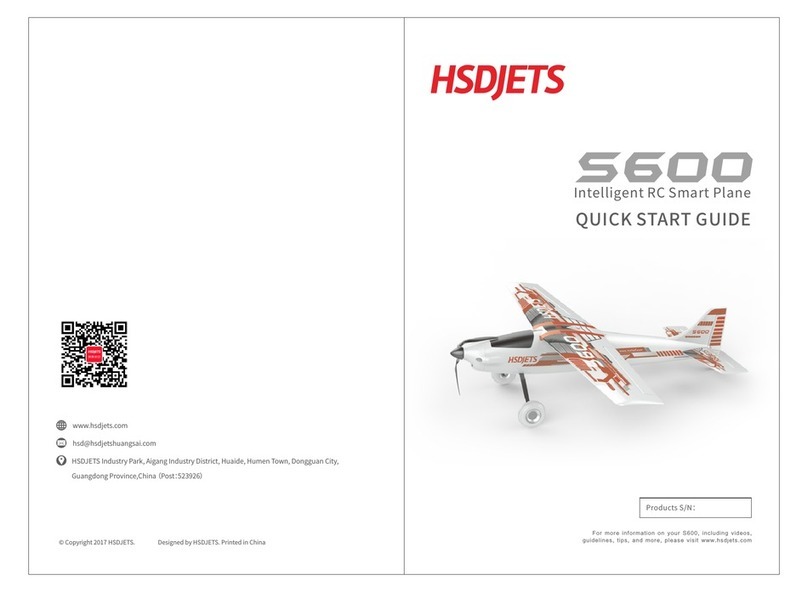lDonotallowthebatteriestocomeintocontactwithanykindofliquid.Donot
leavebatteriesoutintherainornearasourceofmoisture.Donotdropthebattery
into water. If the inside of the battery comes into contact with water, chemical
decomposition may occur, potentially resulting in the battery catching on fire,
andmayevenleadtoanexplosion.
lN e v e r u s e n o n - H S D b a t te r i e s . C l i c k i n t o H S D ’s o f f i c e w e b s i t e
www.HSDjets.comtopurchasenewbatteries.HSDtakesnoresponsibilityforany
damagecausedbynon-HSDbatteries.
lNeveruseorchargeswollen,leaky,ordamagedbatteries.Ifyourbatteriesare
abnormal,contactHSDoraHSDauthorizeddealerforfurtherassistance.
lNeverinstallorremovethebattery fromtheaircraftwhenitisturnedon.Do
notinsertorremovebatteriesiftheplasticcoverhasbeentornorcompromisedin
anyway.
lThe battery should be used in temperatures from 10℃ to 40℃. Use of the
batteryinenvironmentsabove50℃canleadtoafireorexplosion.Useofbattery
below0℃canleadtopermanentdamage.
lDo n ot u s e th e ba tter y i n st ron g ele ctr os tati c or el ect ro m ag n et i c
environments.Otherwise,thebatterycontrolboardmaymalfunctionandcausea
seriousaccidentduringflight.
lNever disassemble or pierce the battery in any way or the batter y may leak,
catchfire,orexplode.
lElectrolytes in the battery are highly corrosive. If any electrolytes make
contact with your skin or eyes, immediately wash the affected area with fresh
runningwaterforatleast15minutes,andthenseeadoctorimmediately.
lIf the battery involved in a crash you have to make sure that the battery is
appearancenodamage,noleakage,andnoshapechange.
lIf the battery falls into water with the aircraft during flight, take it out
immediatelyandputitinasafeandopenarea.Maintainasafedistancefromthe
batteryuntilitiscompletelydry.Neverusethebatteryagain,anddisposeofthe
batteryproperlyasdescribedintheBatteryDisposalsectionbelow.Donotheat
batteries.Putoutanybatteryfireusingsandoradrypowderfireextinguisher.
lDonotputbatteriesinamicrowaveovenorinapressurizedcontainer.
lDonotplaceloosebatterycellsonanyconductivesurface.
lDonotputtheloosecellsinthesituationwheretheymightshortcircuit.
lDonotdroporstrikebatteries.Donotplaceheavyobjectsonthebatteriesor
charger.
lClean battery terminal with a clean, dry cloth. When the terminals are dirty,
unintendedenergyconsumptionoraninabilitytochargethebatterymyresult.
lStore the battery singly at a cool and dry place, and charging in every one
month.
lCheckthebatterypowerbeforeeveryflight.
lDonotchargetheremotecontrollerbatteryandtheS600intelligentbatteryat
thesametime.
lImmediatelypreparetolandthea/cwhenthebatteryindicationlevelisshown
low.
Batteryuse
DESCRIPTION
IntelligentBatterySafetyInstructions
To avoid fire, serious injury, and property damage, observe the following safety instructions
whenusing,charging,orstoringthebatteries.
lAlwa ys use a HS D a pproved charge r o r c hargin g h ub. HSD takes no
responsibilityifthebatteryischargedusinganon-HSDchargerorcharginghub.
lNever leave the battery unattended during charging. Do not charge the
battery near flammable materials or on flammable surfaces such as carpet or
wood.
lDo not charge the battery immediately after flight, because the battery
temperaturemaybe too high. Do not chargethebattery until it coolsdownto
nearroomtemperature.Chargingthebatteryoutsideofthetemperaturerange
of0℃to40℃mayleadtoleakage,overheating,orbatterydamage.
lDisconnect the charger when charging finished. Examine the charger
regularly for damage to the plug, enclosure, or other parts. Do not clean the
charger with denatured alcohol or other flammable solvents. Never use a
damagedcharger.
lCharging will stop automatically by fully charge. Disconnect the charger
whenchargingfinished.
BatteryCharging
DesignedbyHSDJETS.PrintedinChina©Copyright2017HSDJETS.
The following terms are used throughout the product literature to indicate various levels of
potentialharmwhenoperatingthisproduct.
Procedures,which ifnotproperlyfollowed,createapossibilityofphysicalproperty
damageandpossibilityofinjury.
procedures, which if not properly followed, create the probability of property
damage, collateral damage, and serious injury or create a high probability of
superficialinjury.

























